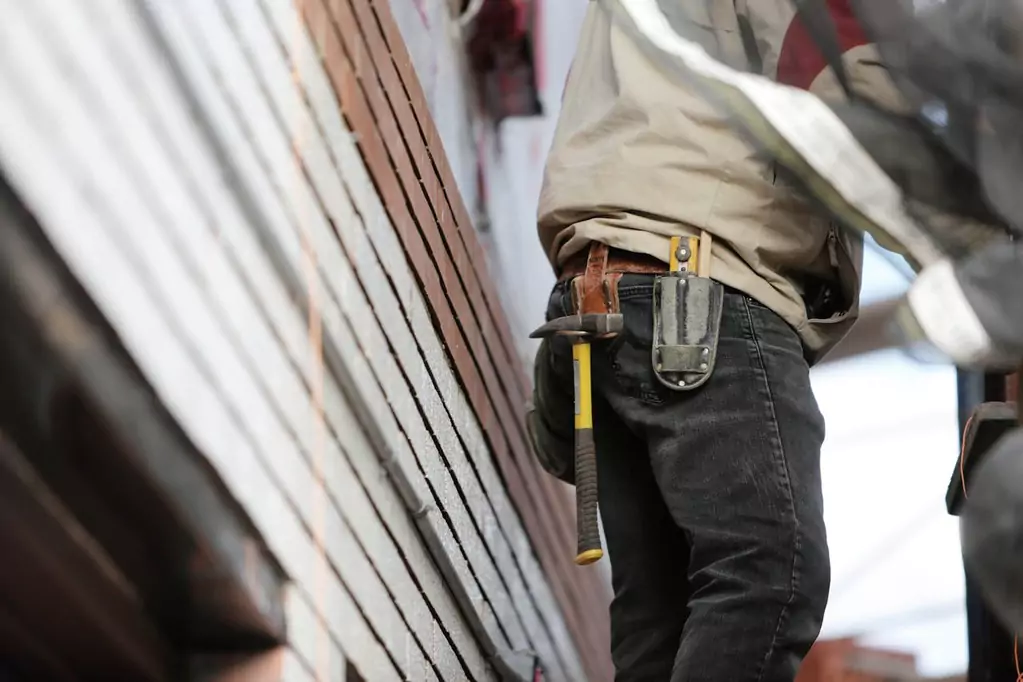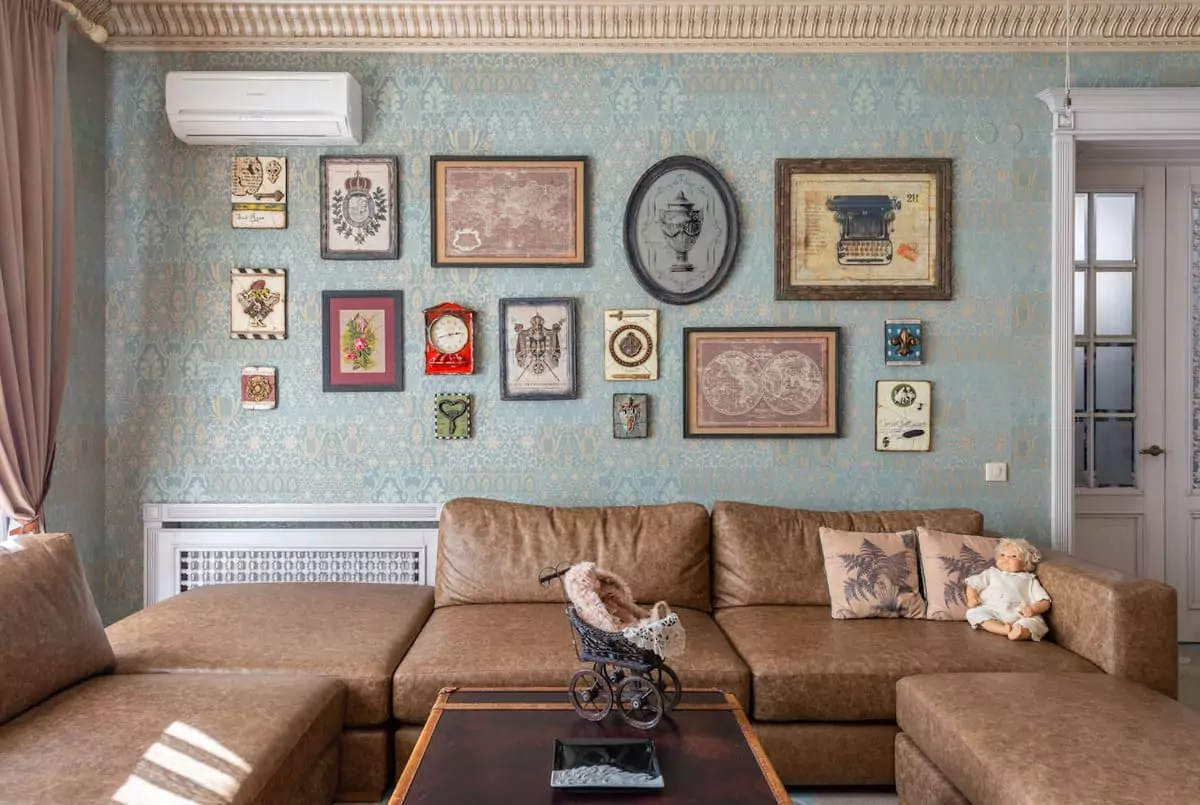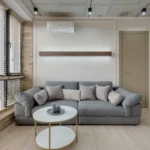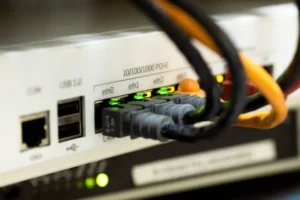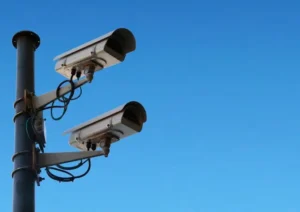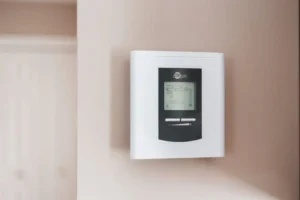Now Reading: What Type of Air Conditioner Is Best for Your Home?
- 01
What Type of Air Conditioner Is Best for Your Home?
- Home
- Home Appliances
- What Type of Air Conditioner Is Best for Your Home?
What Type of Air Conditioner Is Best for Your Home?
![]() Anne MaddisonHome Appliances, Climate ControlJuly 27, 2025160 Views
Anne MaddisonHome Appliances, Climate ControlJuly 27, 2025160 Views
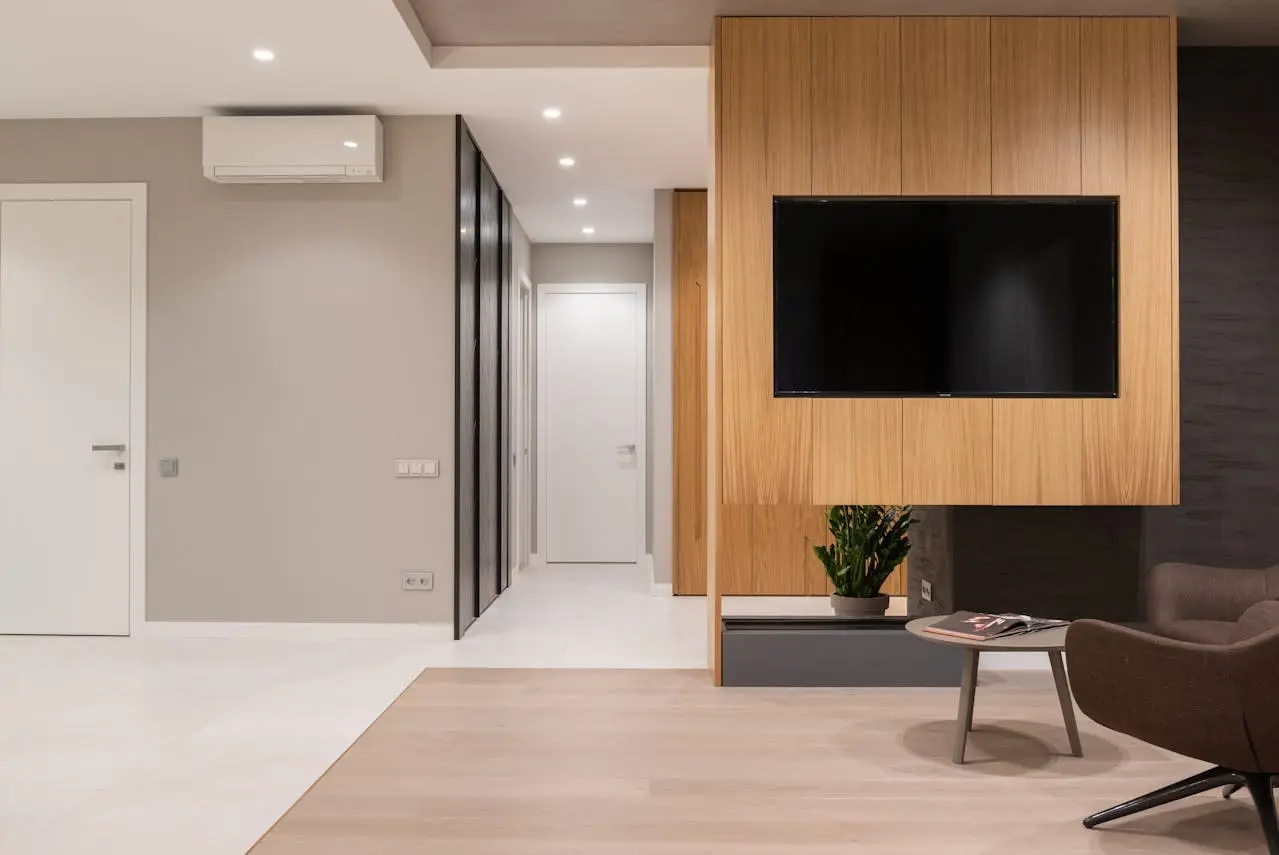
When buying an air conditioner, many people just look at the brand, price, or size. But before you even get to that, there’s something important you need to know: What type of air conditioner do you actually need?
Not all ACs are built the same. Some are made for small rooms, while others can cool down an entire house. Some are stuck to your wall, while others can roll around. You might also hear terms like “inverter” or “non-inverter”—which sound confusing but actually just refer to how the AC works inside.
In this blog, we’ll break down the different types of air conditioners in a way that’s easy to understand. We’ll explain how they’re grouped based on installation style (like window or split units) and how they work (inverter vs. non-inverter). That way, when it’s time to choose, you’ll know exactly what fits your space, your needs, and your budget.
How Are Air Conditioners Categorized
When talking about air conditioners, there are two main ways to group them:
- By how they’re installed – This includes window type, split type, portable, and central AC.
- By how they operate – This is where inverter and non-inverter types come in.
Both of these categories are important to understand. One helps you know what kind of setup your home needs, and the other helps you choose how efficient and powerful your AC will be.
Types of Air Conditioners by How They’re Installed
Air conditioners come in different shapes and setups. The way they’re installed affects how much space they take up, how much they cost, and how well they cool a room. Let’s break down the most common types:
1. Window Type Air Conditioner
Window type ACs are a good choice for bedrooms, small apartments, or if you’re on a tight budget. They’re designed to fit into a window or a hole in the wall, with the front side blowing cool air into the room and the back part sticking out, releasing hot air outside.



One thing to note is the noise level. Since the compressor and fan are both inside the same unit, window-type ACs are usually louder than split-type models, which have their compressor placed outside. However, newer models are now much quieter than older ones, so the noise may not be a big issue—unless you’re very sensitive to sound while sleeping.
Pros | Cons | Maintenance |
Easy to install | Can block your window view | Clean the filter and front grill yourself at least once a month. Don’t open internal parts unless you’re trained. |
Usually cheaper than split or central ACs | Often noisier than other types | Schedule professional servicing every 6 to 12 months for deep cleaning and system checks. |
Simple to use and maintain | Not as energy-efficient as newer split-type models | Regular cleaning is easy, but internal parts should only be handled by a technician. |
2. Split Type Air Conditioner
Split type ACs are a good option for living rooms, master bedrooms, or open spaces. This system has two main parts: an indoor unit that blows cool air into the room, and an outdoor unit that holds the compressor. Since the compressor is placed outside the house, split type ACs run much more quietly indoors.


Although split type ACs cost more upfront and require installation, they are more efficient and quieter, especially for larger spaces or frequent use.
Pros | Cons | Maintenance |
Quiet operation (since the noisy part is outside) | Higher upfront cost | Clean the filters and front panel yourself once a month. Avoid opening the indoor unit casing. |
More energy-efficient than window types | Needs a professional to install | Have both the indoor and outdoor units professionally serviced every 6 to 12 months to maintain performance. |
Sleek and modern design | Not portable—once it’s in, it stays put | Filter cleaning is easy, but deeper cleaning—especially the outdoor unit and internal components—should be done by a technician. |
3. Portable Air Conditioner
Portable ACs are a flexible option if you can’t install a unit or need cooling in different rooms. These units sit on the floor and come with a hose that must be placed out a window to release hot air.
💡Tip: Make sure the exhaust hose is set up properly through a window or wall opening. If not, the hot air will stay in the room, making the AC less effective.


These are best for short-term use or spaces that don’t allow built-in air conditioners. They may not be as powerful as window or split types, but they work well in a pinch.
Pros | Cons | Maintenance |
Easy to move between rooms | Takes up floor space | Clean the filter and front vents yourself at least once a month. No need to open the unit. |
No permanent installation required | Usually less powerful than window or split types | A professional check-up is recommended every 12 months, ideally before summer. |
Great for renters or temporary cooling needs | Can be noisyRequires window access for the exhaust hose | Maintenance is easy—filters are accessible, and there’s no fixed setup to worry about. |
4. Central Air Conditioning
Central air conditioning is ideal for large homes or buildings where you want to cool multiple rooms at the same time. This system uses a central unit (usually placed outside) and a network of air ducts that distribute cool air throughout the space.
💡Tip: Make sure your ductwork is properly sealed and maintained. Leaks or poor insulation can waste energy and reduce cooling performance.
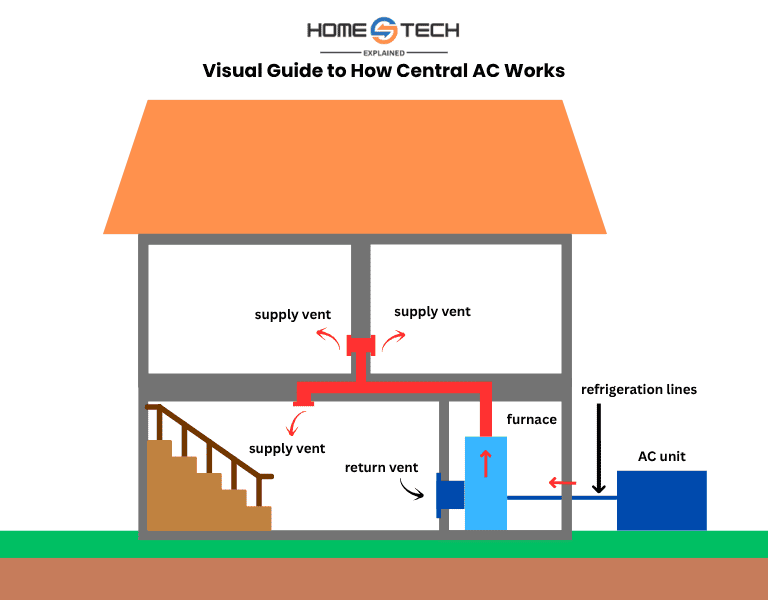


Central AC provides even cooling across rooms and is very efficient for large spaces. However, it requires a higher upfront cost, professional installation, and regular maintenance. It’s a great long-term investment if you’re building or renovating a home and want a clean, clutter-free cooling system.
Pros | Cons | Maintenance |
Cools the whole house evenly | High upfront cost | Replace or clean air filters yourself every 1–3 months. Stick to filters and vents only. |
Quieter since the main unit is outside | Needs ductwork (can be expensive to install if your home doesn’t have it) | Get a professional to check the system at least once a year—this includes refrigerant levels, ductwork, and overall performance. |
Cleaner look—no bulky units in rooms | Can use more energy if you only want to cool certain rooms | Cleaning is moderate to high—anything beyond filters usually requires a trained technician. |
5. Cassette Air Conditioners
Cassette air conditioners are mounted on the ceiling and are best for commercial spaces, offices, or large rooms with drop ceilings. They distribute air in four directions, which helps cool the room evenly without bulky wall units.
💡Tip: Check if your ceiling type can support cassette installation. These units need a false or suspended ceiling for proper setup and must be installed by a professional.

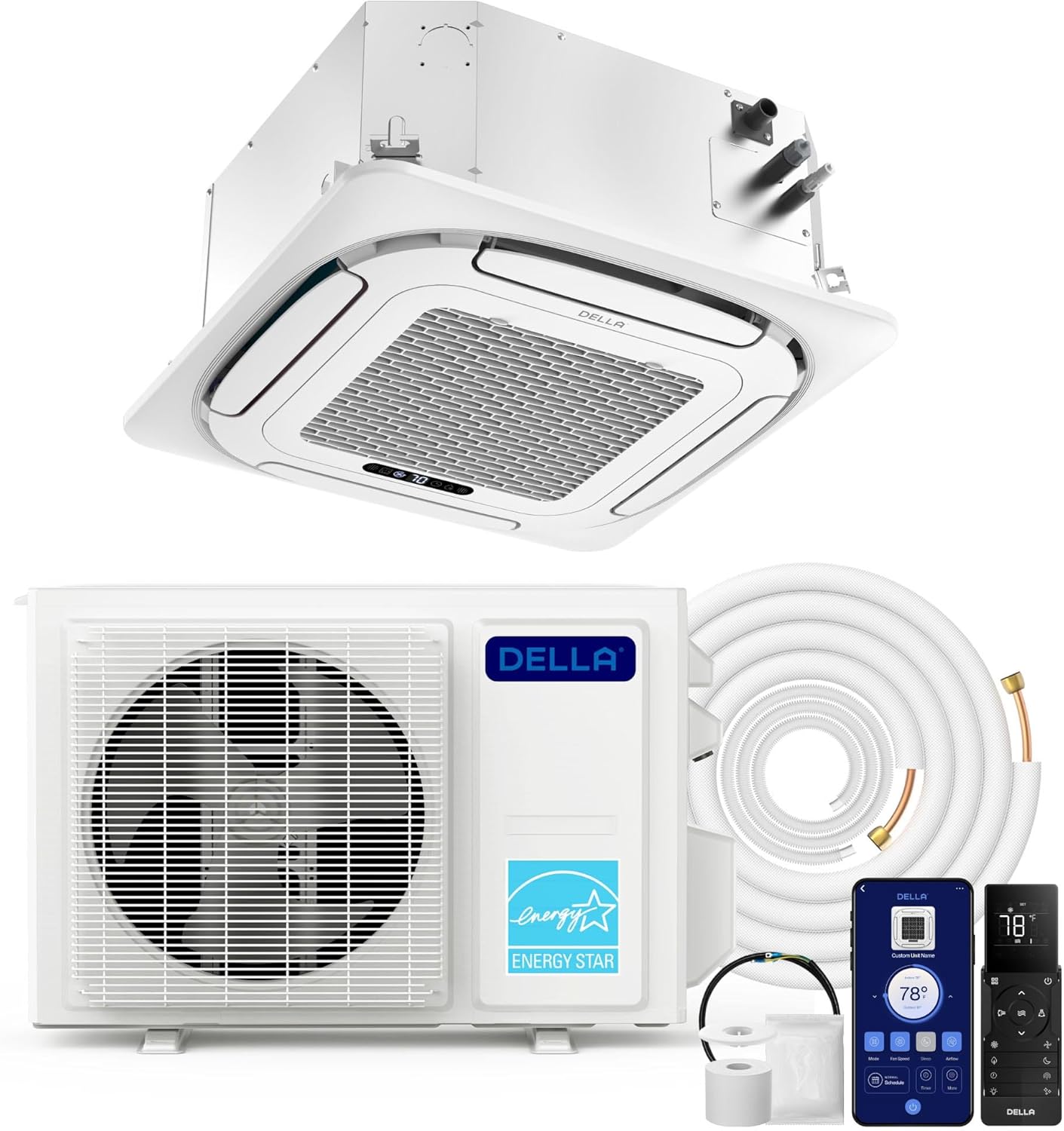
They’re less visible and save wall and floor space, making them a great choice if you want discreet but powerful cooling. Just note that cassette ACs can be more expensive and are usually better suited for large, open-plan spaces rather than small homes.
Pros | Cons | Maintenance |
Great for large or open spaces | More expensive to buy and install | Clean filters monthly if you can reach them. Stick to filters and front panel only. |
Doesn’t take up wall space | Needs enough ceiling space | Professional servicing is needed 1–2 times a year to check drainage, refrigerant levels, and internal components. |
Cools the room evenly in all directions | Harder to clean or repair compared to wall units | Cleaning is difficult—since the unit is in the ceiling, proper tools and expertise are usually required for anything beyond basic filter cleaning. |
Types of Air Conditioners by How They Work
Aside from how an air conditioner is installed, there’s another important way to group ACs: by the type of motor technology they use — inverter or non-inverter.
These terms refer to how the compressor (the part that cools the air) works. Understanding the difference helps you choose an AC that fits your needs and budget.
Non-Inverter Air Conditioner
Non-inverter ACs are traditional types of ACs that work by turning the compressor on and off to maintain your set temperature. Once the room reaches the desired temperature, the compressor shuts off. When the temperature goes up again, the compressor turns back on.
These types of ACs are generally cheaper upfront and easier to repair because they have fewer electronic components. However, they use more electricity because the compressor runs at full speed every time it’s on, consuming more power with each cycle.
Non-inverter units are good for occasional use or if you don’t run your AC for long hours daily. But if you’re cooling your room often or for long periods, an inverter model might save you more on electricity bills in the long run.
Pros | Cons |
Usually cheaper to buy upfront | Uses more electricity over time |
Simple technology, easy to repair | Can be noisy when it turns on and off |
Works fine for small rooms or short use | Temperature may go up and down a lot |
Inverter Air Conditioner
Inverter air conditioners are designed to be more energy-efficient by adjusting the speed of the compressor instead of turning it on and off like non-inverter units. Once the room reaches your set temperature, the inverter AC slows down the compressor rather than shutting it off completely. This helps maintain a steady temperature with less energy.
Because the compressor doesn’t need to restart again and again, inverter ACs use less electricity, run more quietly, and often last longer. They also cool a room faster when first turned on.
Inverter ACs usually cost more upfront, but they can save you money over time through lower electricity bills. They’re a good investment if you use air conditioning daily or for several hours at a time. They work best when used for long periods. They’re ideal for places where the AC runs often, like bedrooms, living rooms, or offices.
Pros | Cons |
More energy-efficient (lower electricity bills) | More expensive to buy |
Keeps the room at a stable temperature | May cost more to repair |
Quieter operation | May not be needed if AC use is very light |
💡 Here’s a comparison table to help you see the differences more clearly
Feature | Inverter AC | Non-Inverter AC |
Motor Speed | Adjusts as needed | Always full power or off |
Energy Efficiency | High (saves electricity) | Low (uses more power) |
Noise Level | Quieter | Louder when turning on/off |
Temperature Control | Steady and comfortable | Fluctuates |
Upfront Cost | Higher | Lower |
Long-term Savings | Yes | No |
Smart Air Conditioners
Smart air conditioners aren’t a separate cooling technology like inverter or non-inverter. Instead, they are regular ACs with added tech features like Wi-Fi control, smartphone apps, voice assistant support (like Alexa or Google), and sometimes energy usage tracking.
It is good for people who want convenience, tech-savvy homeowners, energy-conscious users, or those who travel often
How it works: Smart ACs connect to your home Wi-Fi. Using a mobile app, you can turn them on/off, adjust the temperature, set timers, or check energy usage from anywhere.
Pros | Cons |
Control from your phone or smart assistant | More expensive than regular ACs |
Can help lower electricity bills with smarter scheduling | Needs Wi-Fi and sometimes a learning curve with the app |
Easy to monitor and adjust settings anytime | App updates or bugs may affect performance |
But if you already have an AC installed, you can still make your unit “smart” by using an air conditioner smart controller. These devices are a cheaper alternative to replacing your entire system and offer many of the same benefits.
Smart controllers connect to your existing remote-controlled AC and allow you to operate it via a mobile app, voice assistant, or even automated schedules.

Which AC Type Is the Most Energy-Efficient
Choosing an energy-efficient air conditioner can help you save money on electricity and lower your energy use. Some types of ACs are designed to use less power while still keeping your home cool. But before we talk about which types are the best, it’s important to understand how energy efficiency is measured. Two of the most common ratings you’ll see are EER and SEER.
Energy Efficiency Ratios
EER stands for Energy Efficiency Ratio. It tells you how well an air conditioner works at a specific temperature (usually 95°F or 35°C). It’s a basic way to measure how much cooling you get for each unit of electricity used. EER rating of 10 is considered efficient, 12 or higher is very efficient.
SEER stands for Seasonal Energy Efficiency Ratio. This one looks at how efficient the AC is over an entire season, not just at one temperature. It considers the AC’s performance at different times of the day and under different weather conditions. SEER is more realistic if you use the AC a lot throughout the year. SEER rating of 14 is a good starting point for energy savings, 16 or higher is considered high efficiency.
The general rule to remember is: the higher the number of EER or SEER, the more energy-efficient your AC is.
Best AC Types for Energy Savings
Among the different types, split-type inverter ACs are usually the best for saving energy. Split units cool rooms faster and more evenly. When paired with inverter technology, they avoid wasting power by adjusting the compressor speed instead of turning off and on. This steady control helps reduce electricity use by up to 30% compared to older models.
If you want long-term savings, look for a split-type inverter AC with a SEER of at least 16 and an EER of 12 or more. These models offer powerful cooling, quiet operation, and smarter energy use without overworking your unit.
How to Choose the Right AC for Your Home
Choosing the right air conditioner isn’t just about the price tag. You also need to think about your space, your living situation, and the kind of weather you deal with.
Here are a few key questions to help you make the best choice:
What size room are you cooling?
Room size affects how well your AC works. If the unit is too small, it will struggle to cool the space and stay on for longer, using more electricity. If it’s too big, it cools too fast without removing enough humidity, which can waste energy and leave the room feeling damp.

If you’re not sure what size of AC you need for your room, check out our full guide here. It gives easy tips based on room size so you can choose the right unit from the start.
Do you own or rent?
If you’re renting, a portable or window-type AC is easier to install and remove. If you own your home, you can go for more permanent options like split-type or central AC systems, which are often quieter and more energy-efficient.
What’s your budget?
Window and portable ACs usually cost less up front. Split-type and inverter models are more expensive at first, but they use less electricity over time, helping you save money on bills. Central AC systems are the most expensive to install and maintain but work well for cooling large homes.
Do you live in a hot and humid area?
If you live in a place with high heat and humidity, choose a unit that can cool the air and remove moisture. Inverter and split-type ACs usually handle this better and keep your room more comfortable.
Conclusion
There’s no one-size-fits-all when it comes to air conditioners. The right AC depends on your room size, usage, budget, and climate. Some homes need a powerful split-type unit. Others might do just fine with a small window or portable AC.
Don’t just go for the cheapest or fanciest model. Focus on:
- Comfort – Will it cool your space well?
- Efficiency – Will it save power in the long run?
- Practicality – Can you install and maintain it easily?
When you choose based on what you really need, you’ll end up with an AC that keeps you cool and makes sense for your home.
Disclaimer: Some links on this page are affiliate links. This means we may earn a small commission at no extra cost to you if you make a purchase through them.
Related Posts
Previous Post
Next Post
Climate ControlJuly 28, 2025
Can Air Conditioner Make You Sick?
Climate ControlJuly 27, 2025
What Air Conditioner Size Do I Need?
Climate ControlAugust 24, 2025
Are Home Air Conditioner Tune Ups Necessary
Home AppliancesAugust 23, 2025
Can Air Conditioning at Home Trigger Asthma?
- 03
Home AppliancesJuly 28, 2025
Can Air Conditioner Make You Sick?
- 04
Home AppliancesJuly 27, 2025
What Air Conditioner Size Do I Need?




